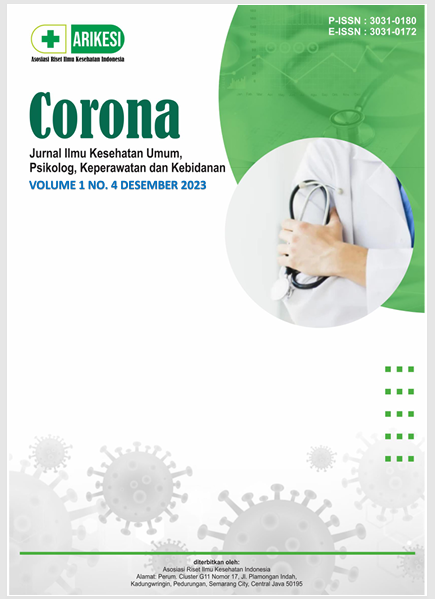Formulasi Dan Evaluasi Sediaan Salep Luka Bakar Basis Hidrokarbon Ekstrak Etanol Daun Katang-Katang (Ipomoea Pescaprae L.) Asal Desa Seith Tahun 2023
DOI:
https://doi.org/10.61132/corona.v1i4.116Keywords:
Katang-katang Leaves, Ointment, Evaluation TestAbstract
Background: Ointment is a semisolid preparation used as a topical medicine, which has direct access to the skin tissues. Katang-katang is one of the medicinal plants traditionally used to treat various types of wounds. Objective: The aim of this study is to identify the secondary metabolite content of katang-katang leaves (Ipomoea pescaprae L.), create and evaluate a good and stable ointment formulation pharmaceutically, and test the irritation of the ointment for burn wounds using ethanol extract of katang-katang leaves (Ipomoea pescaprae L.). Method: The method used is experimental research, the ointment formulation is made using three formulations with different concentrations of active ingredients, with a ratio of FI 20%, FII 25%, and FIII 30%. Result: The results of the study indicate that katang-katang leaves contain flavonoids, tannins, and steroids. The study determined the formulation of a burn ointment from ethanol extract of katang-katang leaves (Ipomoea pescaprae L.). The organoleptic test results of FI, FII, and FIII showed good and stable color, odor, and shape, as well as homogeneity after one week of storage. The pH values measured were 7 for all formulations even after one week of storage. The spreading power of FI was (5.52 cm), FII was (5.88 cm), and FIII was (7.23 cm), which met the standards for good formulation. The irritation tests for all three formulas were categorized as safe. Conclusion: Based on the identification test results, the katang-katang leaves were found to contain flavonoids, tannins, and steroids. The evaluation test results for the three formulations using a hydrocarbon base showed that a good and stable burn ointment could be made from the ethanol extract of katang-katang leaves (Ipomoea pescaprae L.) without causing skin irritation.
Downloads
References
Al-Akayleh, F., Mohammed Ali, H.H., Ghareeb, M.M., Al-Remawi, M. 2018. Therapeutic deep eutectic system of capric acid and menthol: Characterization and pharmaceutical application. J. Drug Deliv. Sci. Technol. 53.
Alminsyah.,H. Indria., dan Sulastrianah, 2014. Uji Daya Hambat Daun Katang-katang (Ipomoea pescaprae L.) R.Br) Terhadap Staphylococcus aureus. Medula 2(1) : 91-96. Program Studi Pendidikan Dokter FK UHO, Fakultas Kedokteran UHO.
Anandhi K., Ushadevi T., 2013, A Study On Antioxidant, Proximate Analysis, Antimicrobial Activity And Phytochemical Analysis Of Ipomoea Pes Caprae By GC-MS. International Journal Of Biotechnology And Alled Fields (UJABF). ISSN: 2320-0774.
Andayani Dahlia, Nugrahani Rizki, 2018. Skrining Fitokimia Dan Aktivitas Antioksidan Ekstrak Etanol Daun Katang-katang (Ipomoea pescaprae L.) Dari Pulai Lombok NTB, Journal of Pharmaceutical Sciences And Clinical Research, Vol 3. No. 2.
Cahyani YN, Kristiningrum N, Wulandari L, 2018. Perbandingan Kadar Fenol Total Dan Aktivitas Antioksidan Ekstrak Metanol Daun Kopi Robusta (Coffea canephora) Dan Arabika (Coffea arabica). Digit Repos Universitas Jember.
Dalvis Stevanie Elisabeth, Selvana S.Tulandi, Olvie S. Datu, Franky Sangande, Douglas N. Pareta, 2022. Formulasi Dan Pengujian Sediaan Salep Ekstrak Etanol Daun Kembang Sepatu (Hibiscus rosa-sinensis L.) Dengan Berbagai Variasi Basis Salep. Journal Biofarmasetikal Tropis. 5(1), 66-73. e-ISSN 2685-3167.
Hafizah, I. (2014). Uji Daya Hambat Ekstrak Daun Tapak Kuda (Ipomoea pes caprae Jurnal Medula 2(1), 91–96.
Idzon, B., dan Lazarus, J., 1986, Semi Solid. dalam Lachman, L. Lieberman, H. A. Kanig, J. L. The Theory and Practice of Industrial Pharmacy, Lea and Febiger Philadelphia, 1091-1099
Kathiresan, S. K., 2014, Antioxidant and Free Radical Scavenging Activities of Ipomoea pes- caprae (L.) R. Br. Extracts, International Journal of Current Pharmaceutical Review anda Research, 5(4), pp. 91-109.
Kemenkes RI, 2019, Profil Kesehatan Indonesia Tahun 2018.
Kiriwenno, J. V, Yunita M, & Latuconsina, V. Z (2021) Perbandingan Aktivitas Antibakten Antara Ekstrak Daun Katang-Katang Upomoea pes- caprae L.) dan Minyak Seith terhadap Pertumbuhan Staphylococcus aureus. Majalah Farmaseutik
Kusumawardhani, A. D., U. Kalsum, I. S. Rini 2015. Pengaruh Sediaan Salep Ekstrak Daun Sirih (Piper betle Linn.) terhadap Jumlah Fibroblas Luka bakar Derajat IIA Pada Tikus Puith (Rattus novergicus) Galur Wistar. Majalah Kesehatan FKUB. Malang.
Lestari, E. 2014. Faktor Risiko Penyakit Kardiovaskuler (Studi Pada Mahasiswa Perokok. Fakultas Teknik Jurusan Mesin Universitas Diponegoro Semarang). Jurnal Kesehatan Masyarakat (e-Journal), 2(1), 67–74.
Mappa, T., H.J., E. and K.N., 2013, Formulasi Gel Ekstrak Daun Sasaladahan (Peperomia pellucid L.) dan Uji Efektivitasnya Terhadap Luka Bakar pada Kelinci (Oryctolagus cuniculus), Jurnal Ilmiah Farmasi, 2(2), pp.49–56.
Muthallib, E.K., Fatimawali, dan Edy, H.J., 2013. Formulasi Salep Ekstrak Etanol Daun Tapak Kuda (Ipomoea pes- caprae) dan Uji Efektivitasnya Terhadap Luka Terbuka Pada Punggung Kelinci. Pharmacon Jurnal Ilmiah Farmasi. 2(3): 79-82, ISSN: Program Studi Farmasi, FMIPA UNSRAT: Manado.
Nugraha, A.C., A.T. Prasetya, dan S. Mursiti. 2017. Isolasi, Identifikasi, UjiAktivitas Senyawa Flavonoid sebagai Antibakteri dari Daun Mangga. Indonesian Journal of Chemical Science 6(2): 91-96.
Putri, Y. D., Kartamihardja, H., & Lisna, I. (2019). Formulasi dan Evaluasi Losion Tabir Surya Ekstrak Daun Stevia (Stevia rebaudiana Bertoni M). Jurnal Sains Farmasi dan Klinis, 6, 32-36.
Saraung, V., Yamlean, P. V. and, & Citraningtyas, G. (2018). Pengaruh Konsentrasi Basis Gel Ekstrak Etanol Daun Tapak Kuda (Ipomoea pes-caprae (L.) R.Br.) Terhadap Aktivitas Staphylococcus aureus. 7(3), 249-256.
Sari D.K. & Wibowo A. 2016. “Perawatan Herbal Pada Rambut Rontok”. Medical Journal Of Lampung University : 5 : 129-134
Wardhani, F. K., & Poedjirahajoe, E. (2020). Potensi Pemanfaatan Ipomoea pes- caprae (L.) R. Br. di Hutan Pantai Petanahan Kebumen. Jurnal Ilmu Kehutanan, 14(2), 145-153.





